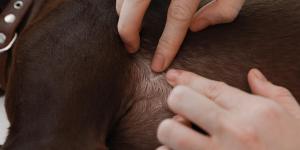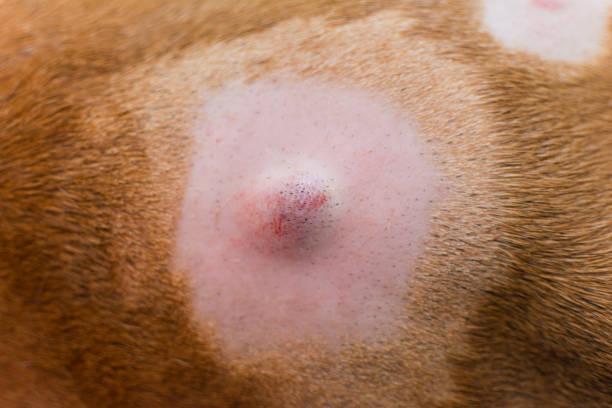Sebaceous Cyst on a Dog - Causes and Treatment



See files for Dogs
Sebaceous cysts in dogs are benign lesions that frequently appear on the skin, especially in older animals. They are cavities surrounded by epithelium tissue that contains the fatty secretion of a sebaceous gland. Sebaceous cysts on dogs can look both painful and potentially harmful, but they are a low-risk skin disease. Although any lump on a dog's skin will require diagnosis, sebaceous cysts are often left untreated. Only in some cases is removal required.
AnimalWised reveals everything you need to know about sebaceous cysts on a dog, focusing on their causes and treatment. We also look at how a dog's sebaceous cyst is removed when the veterinarian deems it necessary.
What is a sebaceous cyst on a dog?
A sebaceous cyst is a nodular skin lesion of benign origin. It consists of a cavity lined by an epithelium that contains an oily or fatty material inside. Epithelium is the tissue which covers the body and can be found in skin. These types of cysts frequently appear in older dogs, especially on the head, neck and trunk. Despite these areas being more frequent, they can appear almost anywhere on the dog's body.
There are certain breeds especially predisposed to developing this type of cyst. The following dog breeds are prone to developing sebaceous cysts:
- Shih Tzu
- Boxer
- Schnauzer
- Yorkshire Terrier
- Doberman Pinscher
This implies there is some genetic predisposition to developing sebaceous cysts in dogs. Despite their prevalence in certain breeds, dogs of any breed and also in mixed-breed dogs can develop this type of lump on a dog's skin.
Causes of sebaceous cysts on dogs
Sebaceous cysts arise when the duct of a sebaceous gland becomes blocked. Sebaceous glands are structures associated with hair follicles that are responsible for secreting sebum. This is a lipid substance that keeps the animal's skin and hair nourished and conditioned, as well as protected from the external environment.
When a hair follicle becomes clogged, the fatty content produced by the sebaceous glands cannot escape to the outside. In turn, this causes the sebum to accumulate, giving rise to a sebaceous cyst. The causes that can cause the obstruction of a hair follicle are variable, but include:
- Skin trauma: if the follicles are damaged by blunt force, it can block the release of sebum and result in a cyst.
- Skin infections: when a skin infection occurs pathogens such as bacteria might be involved which lead to an infection. The dog's immune system reacts and often causes inflammation and the build up of pus. This can cause the sebaceous glands to become impacted.
- Scars: formation of scar tissue from previous injuries can lead to damage of the hair follicles. This means sebum cannot escape when produced and results in a cyst.
- Poor grooming: although not directly related, if the dog's coat is neglected by their guardian, it can encourage sebum buildup and impaction. This is particularly common in breeds prone to the disease.
- Hormonal imbalance: a higher production of certain hormones can increase sebum production. This overproduction of sebum is conducive to cyst development.
It is also important to note that age is a factor in development of sebaceous cysts. It is a skin condition which is more common in older animals, although it is also related to other health conditions such as hypothyroidism in dogs.
Symptoms of a sebaceous cyst in dogs
Sebaceous cysts present as nodules of variable size (generally between 0.5 and 5 cm). Unlike other types of lump such as a lipoma in dogs, sebaceous cysts are firm and well defined. They normally appear as single nodules, although multiple nodules can also occasionally occur in the same or different regions of the body.
Generally, sebaceous cysts are slow-growing and painless nodules that do not cause any discomfort to animals. When the cyst capsule has a lot of tension, it can rupture and release its fatty contents to the outside of the skin. In these cases, there is a risk that the bacteria present on the skin penetrate the lesion and cause a secondary infection. This can produce secondary infections and even result in an abscess on the dog's skin.

Diagnosis of a sebaceous cyst in dogs
The presumptive diagnosis of sebaceous cysts can be made by simple observation and palpation of the lesion. The presence of a firm and well-defined skin nodule can make us suspect a sebaceous cyst.
To confirm the diagnosis and rule out other more serious processes, it is necessary to perform complementary tests. This is because a sebaceous cyst can be similar in appearance to more problematic problems such as cutaneous histiocytoma. Specifically, a fine needle puncture of the lesion should be performed to aspirate the content and observe it under a microscope. Only in this way can it be verified that the content of the lesion is fatty material produced by an obstructed sebaceous gland.
Location of a lump on a dog's skin can help diagnosis. Take a look at our article on why there is a lump on a dog's testicle to learn more.

Treatment for a sebaceous cyst in dogs
As we have stated, a sebaceous cyst on a dog is not usually a cause for concern. Only when the inflammation causes potential harm to the dog is the veterinarian likely to remove it. In this way, treatment of a sebaceous cyst on a dog is not usually required. The dog can have a high quality of life with the cyst on their skin. Even so, it is important that the cyst be monitored closely in case any changes develop.
In certain cases, it may be advisable to remove the sebaceous cyst. This will need to be determined by a veterinarian who may recommend excision in the following circumstances:
- Location: when cysts are located in places that are uncomfortable for dogs (especially when they are located in the ear, on the extremities or in joints).
- Size: when the cysts are larger than usual.
- Rupture: cysts can rupture and drain their contents outside, but over time may reappear. When they are located on areas such as the dog's paw or near their collar, the probability of rupture is increased.
In any case, the removal of a sebaceous cyst should always be carried out by a veterinary professional. This is because it needs to be carried out in a clinical setting, even if it is considered a minor surgery.
Can I remove my dog's sebaceous cyst myself?
Since the condition is considered benign and the surgery for excision is minor, many guardians wonder if they can remove a dog's sebaceous cyst themselves. In these cases, the guardian should not remove the cyst at home. This is because of the risk of infection and other secondary complications. In addition, even if the cyst is drained, it does not mean the sebum cannot still collect and the lump can reappear.
My dog's sebaceous cyst has ruptured
In the case of a dog's sebaceous cyst rupturing, it is important you go the veterinary center to prevent opportunistic bacteria from entering the cavity and causing a secondary infection. The professional will clean the area and finish draining the cyst if necessary. We insist that guardians do not try to burst cyst at home because it could become infected and worsen your dog's health condition.
If your dog has more lumps and you suspect that they could be something other than a sebaceous cyst, you will need to speak to a veterinarian. They will be able to differentiate between other lumps such as skin tumors on dogs.
This article is purely informative. AnimalWised does not have the authority to prescribe any veterinary treatment or create a diagnosis. We invite you to take your pet to the veterinarian if they are suffering from any condition or pain.
If you want to read similar articles to Sebaceous Cyst on a Dog - Causes and Treatment, we recommend you visit our Skin problems category.







